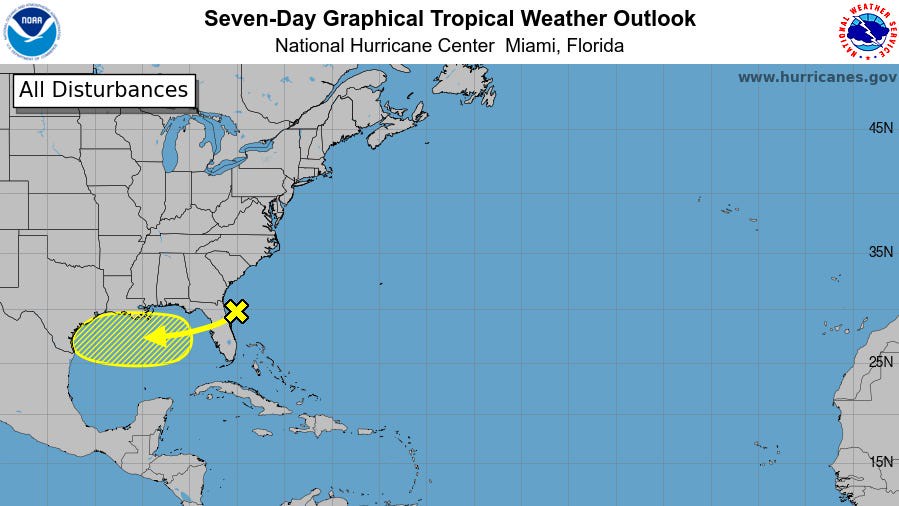news
NHC Tracks Tropical System with Unusual Path; Gulf Coast Braces for Heavy Rain
States along the Gulf Coast could see heavy rainfall from a low-pressure system currently off the northeastern Florida coast.
Published July 23, 2025 at 2:39pm by Brandi D. Addison

States along the Gulf Coast could see heavy rainfall from a low-pressure system currently off the northeastern Florida coast.
In a July 23 advisory, the National Hurricane Center said the system is "associated with a broad area of disorganized showers and thunderstorms."
Forecasters expect the system to move west-southwest into the north-central Gulf, where conditions may support slow development. It follows a pattern similar to last week’s disturbance, which brought heavy rainfall to Louisiana and Mississippi.
"By this weekend, the system is likely to move inland, ending its chances for development," the NHC said in the advisory. "Regardless of formation, heavy rainfall could be possible for portions of Florida over the next day or so, and for the northern Gulf Coast through this weekend."
The system comes during a relatively slow hurricane season, with only three tropical storms recorded so far.
Experts initially forecast an above-average season, but Colorado State University meteorologists recently downgraded that outlook to "slightly above normal," now predicting up to 16 named storms, including eight hurricanes and three major hurricanes (Category 3 or stronger).
Will the tropical system impact Texas?
The National Hurricane Center gives the system a 10% chance of development over the next seven days.
It’s too early to say whether it will impact Texas, though the National Weather Service in Houston notes that rain chances are expected to increase late this week.
What is a 'homegrown' system?
A "homegrown" or "homebrew" storm is one that forms close to the U.S. coast, often in the Gulf of Mexico, the western Caribbean, or the nearby Atlantic. These storms are more common during the early part of the hurricane season, which runs from June 1 to Nov. 30, according to an online forecast discussion from AccuWeather.
While Cape Verde hurricanes — which form from tropical waves off the coast of Africa — account for about 85% of major hurricanes and 60% of all tropical storms and hurricanes, most of these storms stay out to sea or weaken before reaching the mainland U.S. They can be extremely powerful when they do make landfall, but that’s relatively rare.
In fact, only eight out of 54 hurricanes that struck the U.S. between 1995 and 2023 originated as Cape Verde systems, according to storm track data.
These so-called "homegrown" storms tend to form or intensify quickly in warm, shallow waters near the coast, leaving little time for preparation. Because of their proximity, they’re often considered the greater threat to the U.S., even if they’re shorter-lived or not as strong as Cape Verde storms.
Atlantic storm tracker
This forecast track shows the most likely path of the center of the storm. It does not illustrate the full width of the storm or its impacts, and the center of the storm is likely to travel outside the cone up to 33% of the time.
Prepare now for hurricanes
Delaying potentially life-saving preparations could mean waiting until it’s too late. "Get your disaster supplies while the shelves are still stocked, and get that insurance checkup early, as flood insurance requires a 30-day waiting period," NOAA recommends.
- Develop an evacuation plan: If you are at risk from hurricanes, you need an evacuation plan. Now is the time to begin planning where you would go and how you would get there.
- Assemble disaster supplies: Whether you’re evacuating or sheltering-in-place, you’re going to need supplies not just to get through the storm but for the potentially lengthy aftermath, NOAA said.
- Get an insurance checkup and document your possessions: Contact your insurance company or agent now and ask for an insurance check-up to make sure you have enough insurance to repair or even replace your home and/or belongings. Remember, home and renters insurance doesn’t cover flooding, so you’ll need a separate policy for it. Flood insurance is available through your company, agent, or the National Flood Insurance Program. Act now, as flood insurance requires a 30-day waiting period.
- Create a family communication plan: NOAA said to take the time now to write down your hurricane plan, and share it with your family. Determine family meeting places, and make sure to include an out-of-town location in case of evacuation.
- Strengthen your home: Now is the time to improve your home’s ability to withstand hurricane impacts. Trim trees; install storm shutters, accordion shutters, and/or impact glass; seal outside wall openings.

